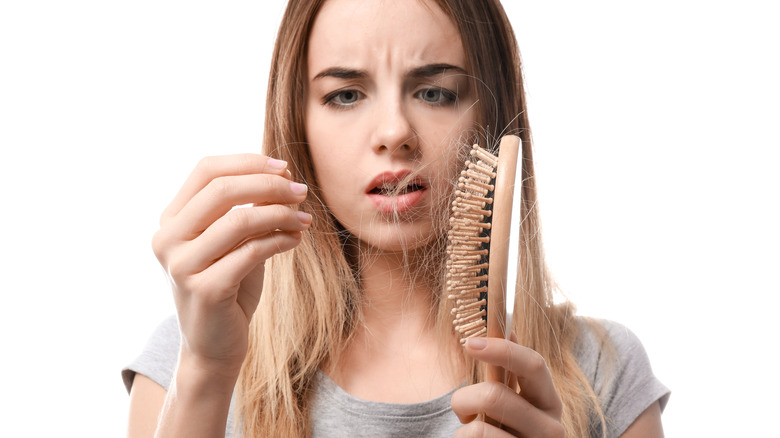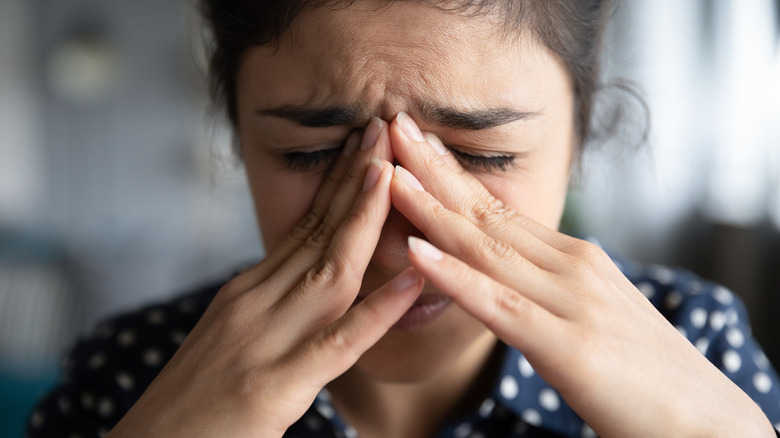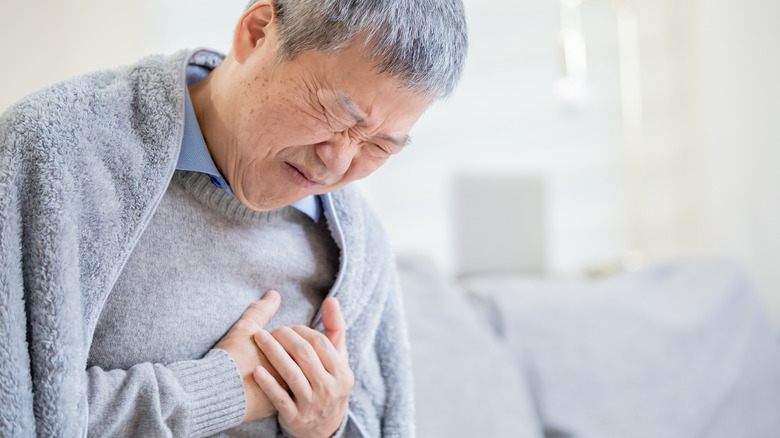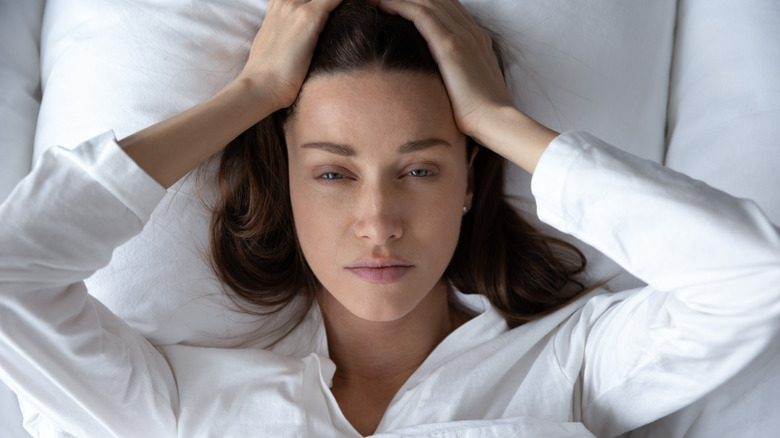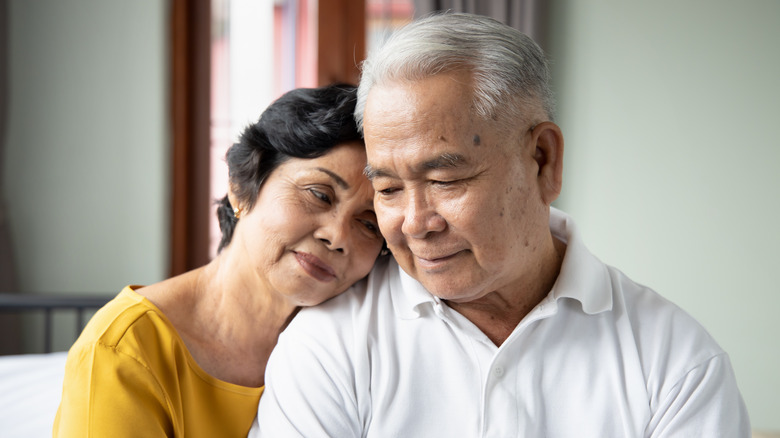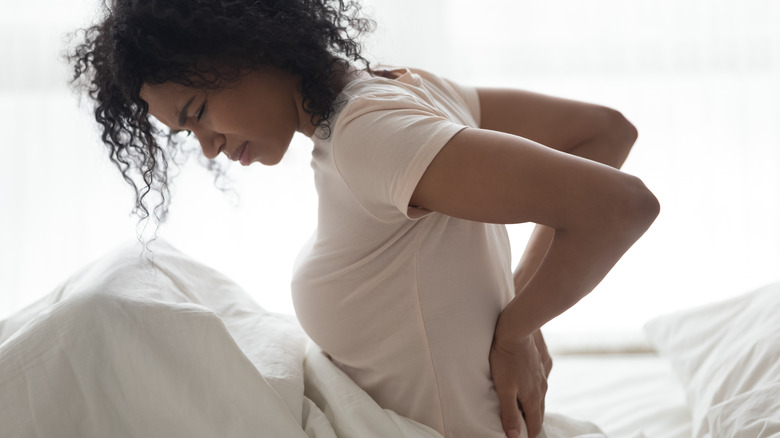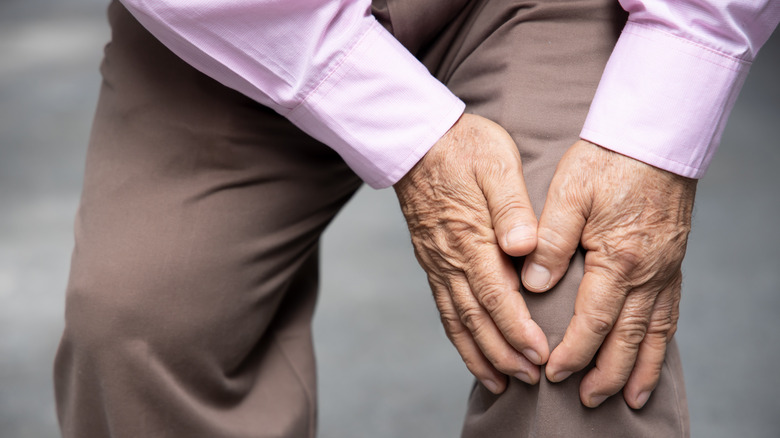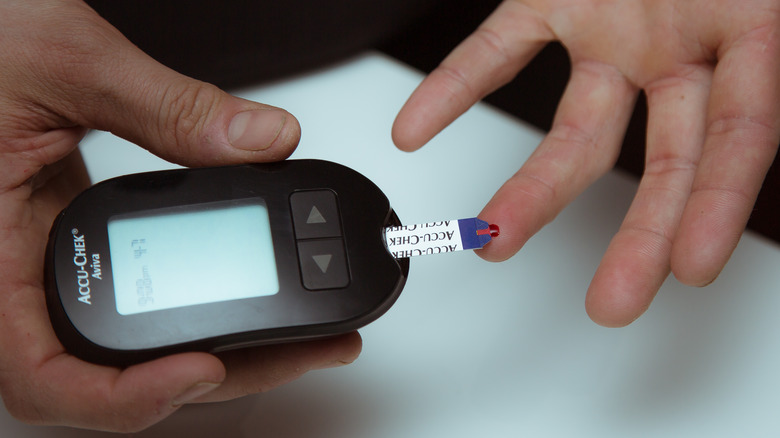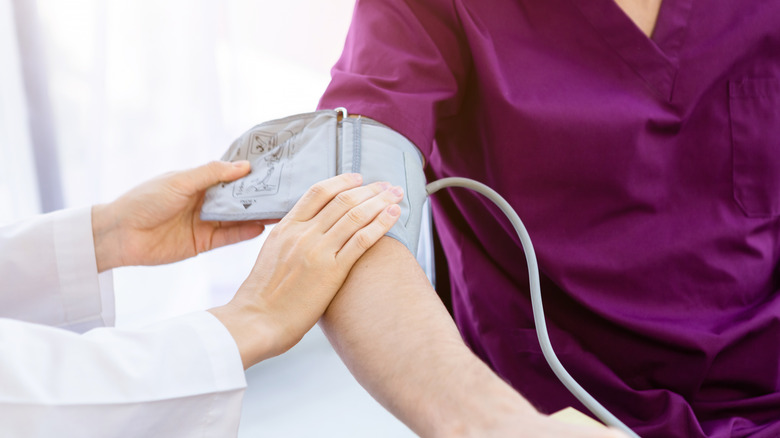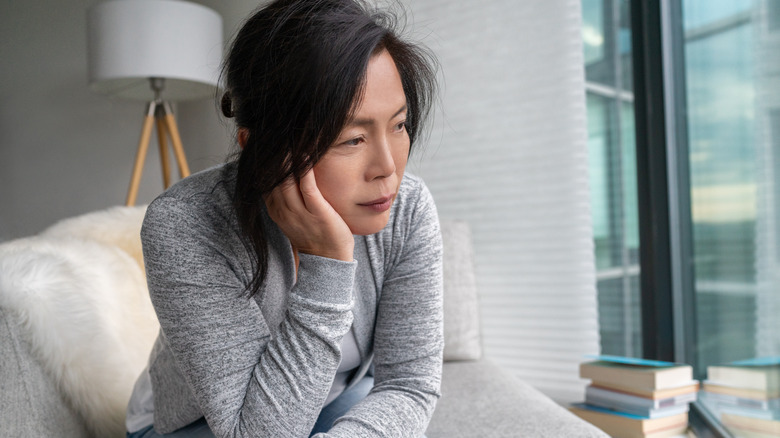Health Conditions That Affect Men And Women In Different Ways
Men and women are vulnerable to a lot of the same medical conditions, such as heart disease, cancer, stroke, or even hair loss. Yet many factors may make these health issues a challenge to diagnose and treat because they often affect the sexes in different ways.
Healthcare professionals may also complicate the situation by showing gender bias toward their patients and hindering treatment. When researchers at the University of Copenhagen analyzed hospital admissions of 6.9 million Danes over two decades, their study observed that women routinely received delayed diagnoses compared to men, sometimes by multiple years, with very few exceptions.
And the bias doesn't stop with the diagnoses, as women also experience more adverse side effects from drugs than men, per Newsweek. One big reason may be that dosages are too high. "Most drugs currently in use were approved based on clinical trials conducted on men, so women may be overmedicated," suggested a 2020 study that zeroed in on the "one size fits all" guidelines. Drug dosages are usually not adjusted for the sexes despite women generally weighing less, having smaller organs, and a higher percentage of body fat.
So let's get to the nitty-gritty and take a look at the similarities and differences in common conditions that affect the sexes.
Hair loss
You're brushing your hair and you see it: Strands of your locks, an alarming number of them, wound around your brush or scattered across the bathroom counter. If you're a woman, the thought of losing hair is kind of freaking you out. If you're a guy and male-pattern baldness runs in your family, you might not be as surprised, but your retreating hairline is just as unsettling.
Hair loss strikes many of us, regardless of gender, for varied reasons, says Harvard Health. About one-third of women will experience hair thinning because of medications they're taking, stressful life events, inflammatory conditions, hormonal shifts, or nutritional deficiencies. For men, hair loss is primarily hereditary, and about half will experience male-pattern baldness by the age of 50. "If your dad or uncle are bald, chances are good you can't escape a similar fate," declares the Cleveland Clinic. The good news is that a variety of effective treatments are at the ready for regrowing lost hair for both men and women, according to the Cleveland Clinic Journal of Medicine.
Anxiety
Anxiety disorders affect far more women than men, according to a 2016 study. The reasons are varied, say the experts, but are likely a combination of biological differences, hormones, and societal pressures, reveals Forbes. Both sexes suffer from anxiety and share common symptoms such as sleeplessness, excessive worry, and difficulty concentrating, but it's women who typically exhibit sadness and seek out professional help. Men, on the other hand, are not as inclined to talk about their emotions and may become aggressive or turn to high-risk activities, says Premier Health.
"Women are more frequently diagnosed with depression and anxiety, and the taking of prescribed psychotropic drugs is also significantly higher," says Amaia Bacigalupe, Ph.D, who co-authored a 2020 study that saw significant differences in how mental health care was managed for women and men. "All this could point to the existence of a medicalization process of mental health in women," she told Psychiatric Times.
Heart attack
When you think of someone having a heart attack, you'll probably visualize a man consumed with chest pain. While it's certainly a valid sign of heart attack, it's actually not how most women experience the condition. "Women are much more likely to have atypical heart attack symptoms," says Dr. Lili Barouch, director of the Johns Hopkins Columbia Heart Failure Clinic. Both sexes can have chest pains, but "women are much more likely to get less common symptoms such as indigestion, shortness of breath, and back pain, sometimes even in the absence of obvious chest discomfort," she told Johns Hopkins Medicine.
Despite the many differences, men and women also share a lot of the same risk factors for heart attack, including obesity, smoking, and diabetes. For women, the chance of heart attack increases after menopause because estrogen levels drop and there's a gradual rise in blood pressure. "In fact, a woman's risk of having a heart attack before menopause is much lower than a man's at the same age. But 10 years after menopause, the number of women having heart attacks rises significantly," declares Dr. Smriti Banthia, a cardiologist with Franciscan Physician Network Indiana Heart Physicians in Indianapolis (via Franciscan Health).
Alcohol abuse
Whether your happy hour cocktail habit has gotten out of hand or you're just single-handedly emptying wine bottles at home, alcoholism is a disease that doesn't discriminate.
Drink for drink, women's blood-alcohol levels are typically higher than in men, and the effects are felt quicker, last longer, and are harder on their systems. The higher concentrations of alcohol in the blood occur, according to the National Institute on Alcohol Abuse and Alcoholism (NIAAA), because women have less water in their bodies. "Women start to have alcohol-related problems sooner and at lower drinking levels than men," the NIAA says. Long-term damage to health is harsher too, leading to more liver damage, heart disease, and brain damage than in men.
Men are twice as likely to binge drink compared to their female counterparts, says the CDC, as well as become more aggressive and end up in the hospital from alcohol-related issues. Alcohol abuse may also result in erectile dysfunction. Though men drink more often, women are closing the gap. Dr. Leena P. Mittal, chief of the Division of Women's Mental Health at Brigham and Women's Hospital, told Psychiatry Advisor, "Alcohol use in women is complicated, as there is a social acceptance of alcohol use as a coping strategy, and this is reflected even in the marketing of alcohol products to women, such as 'Mommy Wine Culture.'"
If you or anyone you know is struggling with addiction issues, help is available. Visit the Substance Abuse and Mental Health Services Administration website or contact SAMHSA's National Helpline at 1-800-662-HELP (4357).
Migraines
Migraines are in a class of their own when it comes to crippling headaches. The combo platter of head pain, nausea, and light sensitivity is a "spectacular neuro-physiological event," says Dr. Andrew Charles, director of the headache research and treatment program in the UCLA Department of Neurology (via NPR).
Migraines affect both sexes, but not equally and at different times during their lives. "There are likely many different pathways not working properly in the brain that lead to an attack," says Michael Oshinsky, Ph.D., program director of pain and migraine at the National Institute of Neurological Disorders and Stroke. "It's a disorder of the nerves and the brain," he told the Washington Post.
Males experience more migraines before puberty, but females ultimately get the brunt of them, up to three times more than males. They ramp up in adolescence, continue climbing into a woman's mid-30s, and finally relinquish their grip by menopause, reports the Cleveland Clinic. Experts believe hormones play a role, but it's more complicated than that.
"We don't have the answer for why migraines are more common in women than in men, but women are more susceptible to every pain condition than men," says Dr. Janine Clayton, director of the office of research on women's health at the National Institutes of Health (via the Washington Post).
Alzheimer's disease
Two-thirds of people with Alzheimer's disease — the most common cause of dementia — are women. One big reason, per Harvard Health, is that women live longer than men. "The greatest risk factor for Alzheimer's disease is age: the older you are, the more likely you are to develop Alzheimer's disease."
But that's just part of the story. According to researchers, women may also be more susceptible to Alzheimer's disease because they have stronger immune systems. A 2018 publication in the journal Neuron notes that stronger immune systems in females also makes them more prone to inflammatory and autoimmune diseases. Amyloid plaques are a cause of Alzheimer's disease, and they may be left behind when the immune system is fighting those infections in the brain, reveals Harvard Health.
Keeping the mind active by working outside of the home through middle age also appears to slow memory decline by about 60%, according to UCLA research. "Women over 50 are the ones most likely to give up their job or retire early because they are caregiving for older parents or other loved ones," says Helen Fernandez, a geriatrician at Mount Sinai Hospital in New York City. "But 20 years down the road, they are going to be the ones who suffer from more cognitive impairment and dementia," she told AARP.
Urinary tract infections
If you're a woman, you've probably experienced a urinary tract infection (UTI) at least once in your life. Up to 60% of women get a UTI compared to just 12% of men, reports Everyday Health. Women get the vast majority of them because of anatomy — a short urethra — making it easy for bacteria to get into their system and cause infection, says the Mayo Clinic. Most cases, however, only make it as far as the bladder and urethra in the lower urinary tract.
Men's anatomy, by contrast, works in their favor for side-stepping this uncomfortable condition. "The longer urethra in men makes it more difficult for bacteria to travel backward that far without being washed out or killed by the immune system," explains Dr. Landon W. Trost, a urologist at the Mayo Clinic (via Everyday Health).
But men do get the condition, especially if they are over age 50 with an enlarged prostate (which makes urination difficult) or at any age if they have diabetes, kidney stones, engage in anal sex, are uncircumcised, or have a sexually transmitted infection like chlamydia or gonorrhea, according to K Health.
Chronic pain
Women received the short end of the stick when it comes to chronic pain. Research shows that women are more subject to painful, chronic conditions, such as migraines, fibromyalgia, irritable bowel syndrome, and menstruation pain, which aren't easily diagnosed because they don't show up on scans or blood tests, reports the Washington Post.
A 2016 study suggested that biological differences in the immune system were key to the issue."The clear sex differences in immune system function have implications for other disorders in addition to chronic pain and should be considered in the development of treatments and the preclinical studies that underlie them."
Women's pain is not only more intense, reveals NPR, but also not taken as seriously as their male counterparts by the medical community. Based on the findings of a 2021 study, female pain tends to be dismissed by doctors as exaggerated or psychological. "Women have been more often referred to psychologists or psychiatrists, whereas men are given tests to rule out actual organic conditions," says Christin Veasley, co-founder and director at the Chronic Pain Research Alliance, via BBC.
Osteoporosis
Most people don't even know they have osteoporosis until a bone breaks, such as a hip. That's what this condition does: It makes bones weak and brittle. It's typically thought of as a woman's disease, but men can get it as well. "Osteoporosis starts earlier and gets worse faster in women because of midlife hormonal shifts," says Harvard Health, "but starting at about age 65, both sexes lose bone at about the same rate."
For either gender, smoking, heavy drinking, leading a sedentary lifestyle, and poor diet, are leading contributing factors. Women are at a unique risk after menopause, which usually occurs in their 50s, and results in estrogen levels sharply dropping off. Low estrogen in women can negatively affect bone density and structure, per Medical News Today.
Though not as common, men do get osteoporosis. Low testosterone for men is the usual culprit, combined with other conditions. "Men are fortunate because women have pioneered osteoporosis diagnosis and treatment," says Harvard Health. "Men may, however, have fewer treatment choices at this time because some drugs have been tested only in women."
Diabetes
Even at a lower BMI, more men are diagnosed with type 2 diabetes than women, according to the CDC. Being overweight and inactive puts both sexes at greater risk for diabetes, but men's body fat is usually around the waist where visceral fat deposits are linked with the disease. An additional risk factor that men need to watch out for is low testosterone, says WebMD, which further raises the chance of getting diabetes.
Type 2 diabetes usually develops gradually, striking in middle age from the body's inability to regulate sugar levels. It affects about 95% of those living with the disease, per the CDC. Type 1, by contrast, is a genetic disorder and affects just a very small percentage of people. One other type is gestational diabetes, which is a serious but temporary condition, caused by hormonal changes during pregnancy. In all, 37 million Americans have diabetes, representing 11.3% of the population, per the National Diabetes Statistics Report.
Despite fewer diagnoses, women suffer the most diabetes complications, including heart and kidney disease, vision issues, stroke, and depression (via Medical News Today).
Hypertension
A 2019 study published in the journal Hypertension suggests that the risks for severe high blood pressure and ischemic stroke, the most common type of stroke that's caused by a blocked blood vessel in the brain, are greater in women than in men.
Heart disease is the leading cause of death in the United States, per the CDC, and high blood pressure is one of the most critical risk factors. While men have more cases of hypertension in their early to middle aged years, the tables turn for women when they go through menopause. That's when female hypertension rates progressively rise until they exceed the numbers of men, according to an article published in the American Journal of Hypertension.
"There are hidden sex differences in many disease processes that we really don't even know about," says Dr. Tracy Madsen, assistant professor of emergency medicine at Alpert Medical School of Brown University in Rhode Island, and the lead author of the 2019 study. "We may not have enough data to say that tomorrow we need to implement sex-specific guidelines for how we treat hypertension, but we also don't have the data to say that our one-size-fits-all approach to stroke prevention is the right one" (via American Heart Association).
Sexually transmitted diseases
Ladies, be warned: You've been dealt the losing card when it comes to sexually transmitted diseases. In heterosexual sex, women are much more vulnerable to STDs than their male partners simply because of anatomy. Chlamydia, gonorrhea, and syphilis represent the top three sexually transmitted infections in the U.S., affecting over 2.5 million men and women, according to the CDC. Delayed diagnosis and treatment of an STD such as chlamydia can be devastating for a woman, as it can cause infertility and dangerous ectopic pregnancies, reveals WebMD. Yet, for men, it's unlikely to have any serious long-term health consequences at all.
Women in particular are more at risk than men to infection, because female genitalia offers a perfect environment for bacteria and viruses to thrive. And because this area has a more internal design, a woman may not even realize she's acquired an STD such as chlamydia or other STDs, says Everyday Health, as so many other irritations have similar symptoms. In male anatomy, it's much easier to spot a problem and get it promptly addressed.
"If a guy goes into a doctor's office with a urethral discharge," says Dr. Hunter Handsfield, a professor emeritus of medicine at the University of Washington Center for AIDS and STDs, "there are only a very small handful of things that can cause it, and most of those are STDs. Any half-trained medical school student can diagnose it and accurately get it treated," he told CNN.
Depression
An estimated 21 million American adults experienced a depressive episode in 2020, according to the National Institute of Mental Health, and women are nearly twice as likely to being diagnosed with the condition as men. Major depression overwhelms a person's functioning in everyday life. "People's sleep, appetite, concentration, mood, energy level, physical health, and social lives can change dramatically due to the symptoms of depression," New York-based psychologist Yesel Yoon, Ph.D. told Singlecare.
Depression commonly manifests as sadness and low energy. For men, their symptoms may look like persistent headaches, digestive problems, irritability, and increased alcohol or drug use, says the Mayo Clinic. While statistics point to more depression diagnoses for women — and women do have some unique biological changes and predisposition to depression during pregnancy and menopause – some researchers say the reason for the higher stats for women, in large part, is because they seek out professional help more often than men.
Studies show the condition goes underreported in men not only because males seek less assistance, but sometimes because of "unconscious gender bias" in the medical community. Men will often focus on the physical symptoms during an appointment while keeping the emotional side under wraps. This can result in their doctor failing to recognize the main problem.
If you or someone you know is struggling with mental health, please contact the Crisis Text Line by texting HOME to 741741, call the National Alliance on Mental Illness helpline at 1-800-950-NAMI (6264), or visit the National Institute of Mental Health website.
Stroke
Stroke is the third leading cause of death among women, according to the CDC, following heart disease and cancer. If you're a women aged 55 to 75, your odds of being taken down by a stroke are 1 in 5. For men, strokes are a little farther down the list, landing in the number five spot, reports the CDC.
Stroke symptoms in women can look the same as in men or completely different, which sometimes leads to delays in diagnosis and treatment. Instead of the sudden one-sided arm numbness and heart-crushing pain we've been told to expect, a 2021 study reveals a woman's symptoms may initially appear less dramatic, but be just as severe.
Delayed diagnosis is yet another issue, according to a University of Calgary study that found women were 10% more likely to receive a migraine or vertigo diagnosis in an emergency room, even when reporting the same atypical symptoms as men who received a stroke diagnosis. "Women more frequently have atypical, vague symptoms. They might start with fatigue, confusion or maybe general weakness, as opposed to weakness on one side of the body," says Dr. Pooja Khatri, a neurology professor at the University of Cincinnati, via the American Heart Association.


